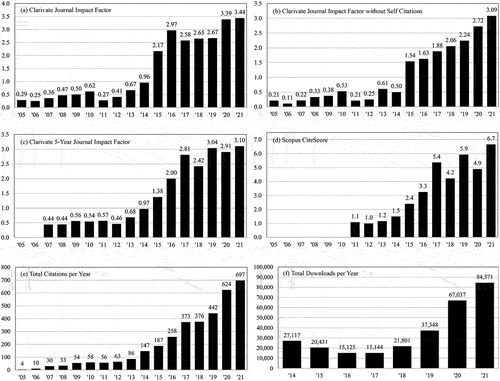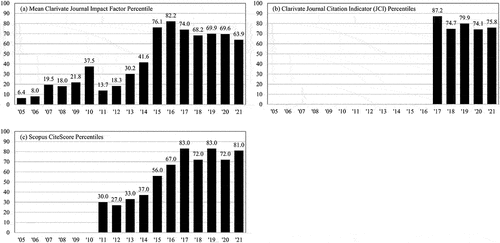Figures & data
Fig. 1. LEUKOS journal-level performance trends. Consistent the San Francisco Declaration of Research Assessment (DORA Citation2012; Taylor & Francis Citation2021), LEUKOS discourages quoting a single journal-level performance measure because any one measure tells only a part of the story of a journal’s quality and impact. Included here are (a) Clarivate’s Journal Impact Factor (JIF), (b) JIF without self-citations, (c) 5-year JIF, (d) Scopus CiteScore, (e) Total citations per year, and (f) Total downloads per year. Some of these measures are best understood with explanation of how they are computed and contextualization. The JIF (Clarivate Citation2022) and CiteScore (Scopus Citation2022) are lagging indicators of impact based on citations. Clarivate generally releases JIF reports in July for the preceding calendar year. The 2021 JIF is computed as (citations in 2021 to items published in 2019 (93) + 2020 (110) = 203) ÷ (citable items in 2019 (20) + 2020 (39) = 59) = 203 ÷ 59 = 3.44. The Clarivate JIF without self-citations removes from the numerator any citing articles that were published in LEUKOS. The Clarivate 5-year JIF is computed with the same formulation, but with a trailing period of five years rather than two years. Scopus generally releases CiteScore reports in the spring for the preceding year, complemented by a CiteScoreTracker that is updated monthly. The 2021 CiteScore is computed as (citations from 2018 to 2021 = 526) ÷ (documents from 2018 to 2021 = 79) = 526 ÷ 79 = 6.7. As of November 5, 2022, the CiteScoreTracker for 2022 is: 674 citations ÷ 90 documents = 7.5. (e) illustrates steady increase in total citations per year. In 2021, there were a total of 697 citations. Of those, 203 citations were to articles published in 2019 and 2020, contributing to the 2021 JIF. The other 494 citations were to articles published in 2021, or between 2004 and 2018. This suggests that LEUKOS content is standing the test of time, with broadening impact. (f) begins in 2014 since that was the first full year of hosting by Taylor & Francis.

Fig. 2. This figure illustrates three measures of percentile performance. LEUKOS is included in two Clarivate Science Citation Index Expanded (SCIE) categories, Optics, and Construction & Building Technology. LEUKOS is included in the Scopus category of Physics and Astronomy, under the heading Atomic and Molecular Physics, and Optics. In 2021, LEUKOS was ranked 27/68 (61%) in the Clarivate category of Construction & Building Technology, 34/101 (67%) in the Clarivate category of Optics, and 39/205 (81%) in the Scopus category of Atomic and Molecular Physics, and Optics. The percentiles shown in (a) are averaged across the two Clarivate categories. (b) illustrates LEUKOS’s Journal Citation Indicator (JCI) percentile, which was retroactively published by Clarivate for the first time in 2021. The JCI is normalized for the widely varying rates of publication and citation in different disciplines. It is intended to better contextualize performance – e.g., the SCIE Optics category includes journals in photonics, nanoscience, lasers, quantum technologies, optomechatronics, and other topics that represent larger fields of study and are not directly comparable to LEUKOS. The percentiles shown in (c) are based on the Scopus CiteScore, which originated in 2011. LEUKOS’s five-year trailing average across all three measures is 75.2%. Taken together, on these measures of citation performance, LEUKOS is in the lower portion of the top quartile or the upper portion of the second quartile.

Table 1. Dark gray background (left): Manuscripts received between 2014 and 2021, subdivided by manuscript type and by new or revised submissions. During the 9-year period between 2005 and 2013, LEUKOS received an average of 29 new submissions per year (Max = 32, Min = 21, Std Dev = 4.2). Light gray background (right): Page budget and actual pages printed from 2014 to present. Volume 10 is the first volume of LEUKOS that was published with Taylor & Francis. Actual pages include front matter and the table of contents.
